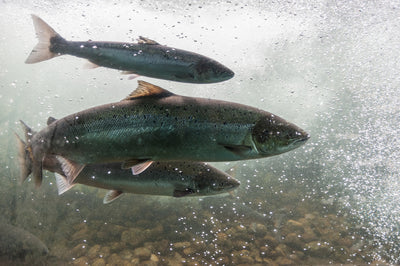Bioaccumulation & Biomagnification Of Toxic Chemicals
RSS
Updated 4/13/22
Since this article was first written, we've continued getting inquiries about endocrine disruptors and methylated mercury, and more recently, lead and PFAS contamination, and how people become exposed to these chemicals. Different routes of contamination include not only drinking water, but also through food, so we wanted to spend some time explaining how this happens.
What is Bioaccumulation?
Bioaccumulation refers to the process of toxic chemicals building up inside of an organism’s body. This happens when a chemical is consumed or absorbed, and the body cannot catabolize or excrete it quickly enough. A contaminant will bioaccumulate inside the body if the rate of intake of the contaminant exceeds the rate it is excreted. Mercury is a well-known chemical that can bioaccumulate in humans. We commonly hear about mercury exposure resulting from eating fish such as tuna (or other large predatory fish). However, mercury as well as many other harmful chemicals can also be found in drinking water supplies across the United States.
Chemicals that tend to bioaccumulate are stored in cells and not exposed to direct physical or biochemical degradation. These chemicals can collect and hide-out, particularly within adipose tissue (fat cells). Fatty mammary tissue often contains the highest concentrations of toxic chemicals. These chemicals in our mammary tissue are then passed along to infants when nursing.
What is Biomagnification?
Biomagnification refers to the process of toxic chemicals increasing in concentration as they move throughout a food chain. Bioaccumulation and biomagnification often work hand-in-hand; one animal accumulates chemicals in the body (bioaccumulation) and then a larger predator consumes that smaller animal such that the chemical is passed along to the predator. The chemical “magnifies” as the resulting concentrations increase in the predator because it likely consumes large quantities of that particular prey throughout its lifetime (biomagnification). As top-level predators in our own food chain, humans tend to collect high concentrations of toxic chemicals in our bodies.
Does Lead Bioaccumulate?
Lead is a particularly toxic contaminant because it is able to persist and bioaccumulate in the body. In humans, the principal organs affected are the central and peripheral nervous system and the cardiovascular (brain and nerves), gastrointestinal (GI tract), renal (kidneys), endocrine (hormone secretion), immune, and hematological (blood) systems. The American Academy of Pediatrics and other health organizations have determined that there is no safe level of human lead exposure, and children are especially vulnerable to exposure to and bioaccumulation of lead.
Bioaccumulation and PFAS
Poly- and perfluoroalkyl substances (PFAS) are a class of chemicals widely used in a variety of applications, including firefighting foam, nonstick coatings, stain-resistant fabrics, and even food packaging and cosmetics. While different forms of PFAS have been in use since the 1950s, relevant studies of its effects on humans did not occur until decades later. In 2013, scientists in Spain published the first paper analyzing the accumulation of different PFASs in samples of various human tissues. They discovered that PFHxA accumulated in highest concentrations in brain and liver, while PFBA levels were highest in kidney and lung, and PFOA was the predominant compound in bone, and finally PFOS accumulated primarily in lung, liver and kidney. The CDC has reported that PFAS has been found in the blood of 97% of Americans.
What are Persistent Bioaccumulative Toxics (PBTs)?
PBTs are a particular group of chemicals that threaten the health of humans and the environment. Examples include methylmercury, polychlorinated biphenyls (PCBs), dichloro-diphenyl-trichloroethane (DDT), and dioxins. PBTs are considered extremely dangerous to both humans and wildlife because they remain in the environment for a very long time without breaking down, then bioaccumulate and biomagnify in ecosystems (including ours).
PBTs can also travel long distances and move between air, water, and land. DDT, a notorious environmental pollutant, was developed as a synthetic insecticide in the 1940s. Sprayed over crops, DDT would then wash into water supplies and contaminate lakes, ponds, streams, rivers, and oceans. Small organisms such as plankton and algae absorb DDT through the water. Smaller fish then consume the contaminated algae and plankton. Larger predatory fish then consume the smaller fish. Eventually, large predatory birds or humans eat the contaminated fish.
Despite being banned in the United States over 40 years ago, DDT is still found in soil and water supplies today. In addition, humans contain the highest concentrations of DDT when compared to other organisms.
Exposure to PBTs has been linked to a wide range of toxic effects in humans and wildlife. Some of those adverse effects include but are not limited to disruption of the nervous and endocrine systems, reproductive and developmental problems, immune system suppression, and cancer.
How Can I Minimize My Contaminant Exposure?
- Avoid eating species of fish that are long-lived and high on the food chain such as tuna, marlin, shark, swordfish, king mackerel, and tilefish.
- Use a high quality water filter that removes PFAS, Lead, and PBTs (e.g. DDT, Dioxins, BPA, Phthalates) from contaminated drinking water before the chemicals get a chance to accumulate in you.
Heavy Metal Toxicity: What You Need to Know
PFAS is Being Detected Everywhere
Is PFAS Exposure Toxic to the Immune System?




